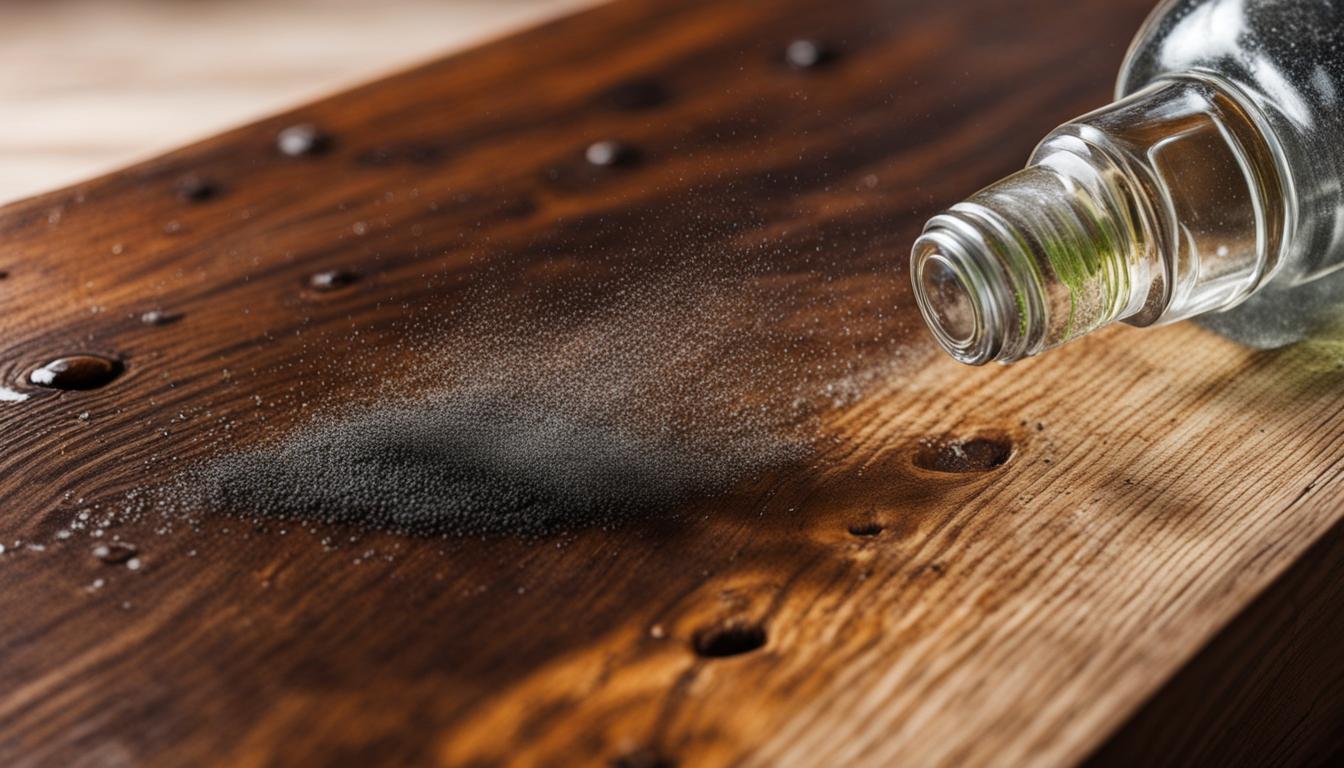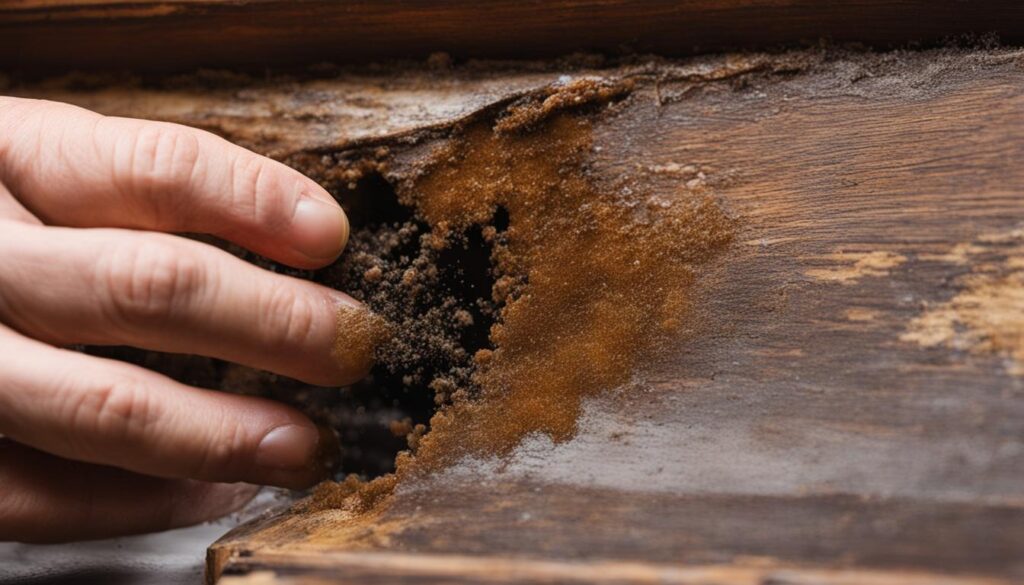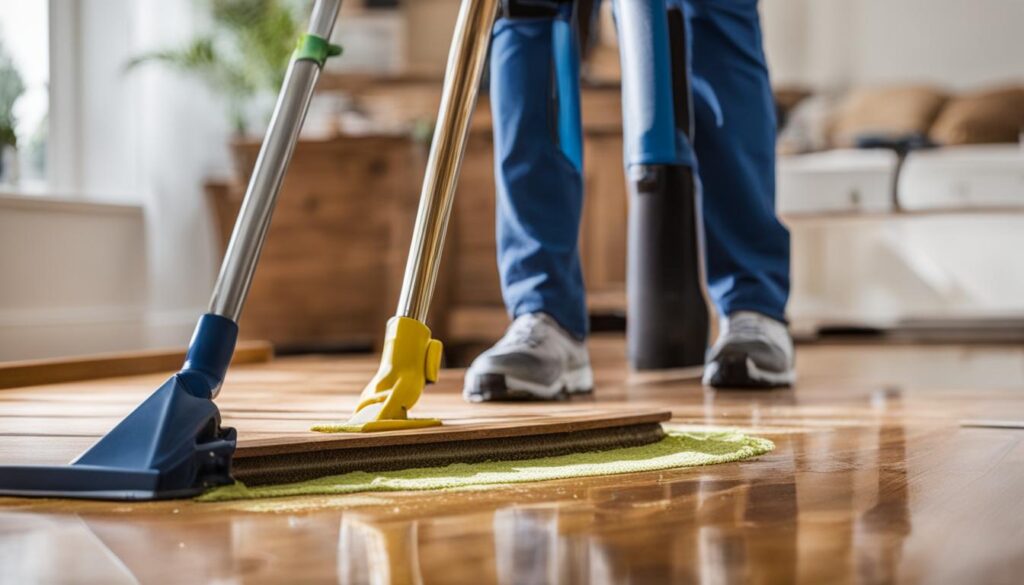
Clean Mold Off Wood – Safe & Effective Methods
If you have noticed mold growing on your wood surfaces, it’s important to address the problem quickly and efficiently. Mold not only damages the appearance of wood but also poses potential health risks. Fortunately, there are safe and effective methods for removing mold from wood, and with the right techniques, you can restore the beauty of your wood surfaces and prevent future mold growth.
In this section, we will discuss how to clean mold off wood, including safe DIY methods, cleaning chemicals, and preventive measures to keep your wood surfaces mold-free.
Key Takeaways:
- Mold on wood can pose health risks.
- Regular inspections and proper moisture control can help prevent mold growth.
- Removing mold from wood requires the use of safe and effective cleaning methods.
- Professional assistance may be necessary in some cases of severe mold growth.
- Proper maintenance can help keep wood surfaces mold-free.
Understanding the Dangers of Mold on Wood
When mold grows on wood, it can pose serious health risks to humans and pets. Exposure to mold spores can cause allergic reactions, respiratory problems, and other harmful health effects. In addition, mold on wooden surfaces can indicate underlying moisture issues that, if left unaddressed, can lead to wood rot and structural damage.
To prevent these dangers, it’s essential to understand mold cleaning techniques and take steps to prevent mold on wood in the first place. Here are some tips to keep in mind:
- Control the humidity and moisture levels in your home or building to prevent mold growth.
- Regularly inspect and maintain wooden surfaces to catch mold growth early.
- Invest in a dehumidifier to keep humidity levels in check, particularly in areas with poor ventilation.
- Use mold-resistant paint or coatings on wood surfaces to prevent mold growth.
By taking these preventive measures and understanding the risks associated with mold on wood, you can help keep your home or building healthy and safe.
Assessing Mold Damage on Wood
Before attempting DIY mold removal or cleaning, it’s important to assess the extent of the damage to ensure that you take the necessary precautions. Mold growth can lead to health risks and cause structural damage to the wood. In this section, we will guide you through the process of assessing mold damage on wood.
Identifying Mold Growth
The first step in assessing mold damage is to identify where mold is growing on the wood surface. Check for visible signs of mold growth, such as discoloration or a fuzzy texture, and sniff for a musty odor.
“If you have a moldy smell in a room, there’s probably mold growing somewhere hidden out of sight.” – Dr. Harriet Burge, Senior Scientist at EMLab P&K
If you suspect that there is mold growth, but you can’t locate it, you can hire a professional mold inspector to conduct a thorough assessment.
Evaluating the Severity of the Problem
After identifying the mold growth, the next step is to evaluate the severity of the problem. This will help you determine whether you can remove the mold yourself, or if you need to seek professional assistance.
If the mold covers a small area, less than 10 square feet, and there are no signs of structural damage or health risks, you can attempt DIY mold removal using effective wood mold cleaning methods.
However, if the mold covers a large area, more than 10 square feet, or there are signs of structural damage or health risks, it’s essential to seek professional assistance. A professional mold remediation service will have the necessary equipment and expertise to carry out safe and effective mold removal.
Signs of Mold Damage on Wood

| Signs of Mold Damage on Wood | Possible Consequences |
|---|---|
| Discoloration | Indicative of mold growth, which can weaken the wood structure over time |
| Musty odor | Indicative of active mold growth, which can cause respiratory problems and allergic reactions |
| Cracks or warping | Indicative of severe water damage, which can cause structural instability and lead to mold growth |
| Soft or spongy texture | Indicative of rot caused by prolonged exposure to moisture, which can encourage mold growth |
By assessing the mold damage on wood, you can determine the best course of action to take and prevent further mold growth. Whether you decide to attempt DIY mold removal or seek professional assistance, it’s essential to wear protective gear such as goggles, gloves, and a respirator mask to minimize the risk of exposure to mold spores.
Cleaning Chemicals for Mold Removal on Wood
Removing mold from wood requires the right cleaning chemicals and solutions. Let’s explore some effective options:
Commercial Mold Cleaners
Commercial mold cleaners contain powerful chemicals that can effectively clean mold off wood. However, they can also be harsh on the wood and may leave behind residue. It’s essential to read the manufacturer’s instructions and handle these chemicals with care. Here are some popular commercial mold cleaners:
| Brand | Product | Active Ingredient |
|---|---|---|
| Concrobium | Mold Control | Sodium Carbonate |
| Home Armor | Mold Remover and Disinfectant | Sodium Hypochlorite |
| Zep | Mold Stain and Mildew Stain Remover | Sodium Hypochlorite and Chlorine Dioxide |
Natural Alternatives
If you prefer using natural ingredients to clean mold off wood, here are some natural alternatives:
- Vinegar: Mix equal parts white vinegar and water, spray onto the affected area and scrub with a brush, then rinse and dry thoroughly.
- Hydrogen Peroxide: Mix equal parts 3% hydrogen peroxide and water, spray onto the affected area and let sit for a few minutes, then scrub and rinse off.
- Baking Soda: Mix ¼ tablespoon of baking soda with water to create a paste, apply to the affected area, then scrub and rinse off.
Using natural alternatives is a safer and eco-friendly option for mold removal. However, they may not be as potent as commercial mold cleaners and may take longer to remove mold from wood.
Precautions When Using Cleaning Chemicals for Mold Removal
When using commercial or natural cleaning chemicals for mold removal on wood, it’s essential to take precautions:
- Wear protective gloves and a mask to prevent contact with the cleaning chemicals and inhalation of mold spores.
- Test the cleaning solution in an inconspicuous area of the wood to ensure it won’t damage the surface.
- Don’t mix different cleaning solutions as it can create dangerous fumes.
- Properly vent the area to ensure good air circulation and prevent the buildup of cleaning solution fumes.
With the right cleaning chemicals and precautions, you can effectively clean mold off wood and restore it to its original condition.
Step-by-Step Guide: How to Clean Mold off Wood
When it comes to removing mold from wood surfaces, it is important to follow specific safety precautions and techniques to prevent further damage. Here is a step-by-step guide to using natural mold cleaning solutions for successful wood mold removal:
Step 1: Prepare the Area
Before beginning, ensure the work area is well-ventilated, and wear protective gear such as gloves, goggles, and a mask to avoid inhalation of spores.
Step 2: Remove Visible Mold
Using a vacuum cleaner with a HEPA filter or a dry cloth, remove any visible mold growth from the surface of the wood. Avoid using water or any cleaning solutions at this point.
Step 3: Apply Natural Cleaning Solution
Mix equal parts of distilled white vinegar and water in a spray bottle. Spray the solution on the affected wood surface and let it sit for an hour. For tougher stains, use a hydrogen peroxide solution instead of vinegar.
Step 4: Scrub the Surface
Using a nylon brush or a scrub sponge, gently scrub the surface of the wood to remove any remaining mold. Avoid using steel wool or abrasive scrubbers, which can cause damage to the wood.
Step 5: Rinse and Dry the Surface
Rinse the wood surface with clean water and dry thoroughly. Ensure that the wood is completely dry before sealing or painting to prevent future mold growth.
Following this step-by-step guide will help you effectively remove mold from wood without causing damage. Additionally, using natural cleaning solutions will prevent harsh chemicals from harming the environment.
Preventing Mold Regrowth on Wood
Simply cleaning mold off wood surfaces is only part of the solution. Preventive measures and strategies are key to keeping your wood free from mold. Here are some effective tips for preventing mold on wood:
- Proper ventilation: Ensure good air circulation in rooms prone to excess moisture or humidity. Use exhaust fans in bathrooms and kitchens, and keep windows open when weather permits.
- Moisture control: Maintain optimal humidity levels in your home by using a dehumidifier or air conditioner. Keep an eye out for leaks or condensation on walls, ceilings, and window sills, and address the problem as soon as possible.
- Regular inspections: Check your wooden surfaces regularly for signs of mold growth, especially in areas with high humidity. Catching mold early can prevent it from spreading and causing further damage.
By implementing these measures, you can significantly reduce the risk of mold regrowth on your wood surfaces and ensure long-lasting results.
Hiring a professional mold remediation service for a thorough inspection and treatment can also be an effective way to prevent mold from returning. If you require expert assistance, contact Fix Mold Miami at 305-465-6653 for a mold inspection.
When to Seek Professional Help for Wood Mold Removal
While DIY mold removal methods can be effective, there are certain situations where seeking the help of a professional mold remediation service is necessary. Here are some signs that indicate you need expert intervention:
- The mold covers an area larger than 10 square feet.
- The mold has spread to hard-to-reach areas such as air ducts, walls, and ceilings.
- You have respiratory problems or allergies that worsen when you’re in the affected area.
- The mold is caused by contaminated water, such as from flooding or sewage backups.
Professional mold remediation services have the necessary equipment, expertise, and experience to handle even the most severe cases of wood mold. They can also identify and address any underlying causes of mold growth, such as water leaks or poor ventilation.
If you do decide to seek professional help, it’s important to choose a reputable company with a track record of successful mold remediation. Look for certified and licensed professionals who offer a comprehensive approach to mold removal and prevention.

Remember that prevention is key when it comes to mold growth on wood surfaces. Regular inspections, proper ventilation, and moisture control can help prevent mold from returning. By following these tips, you can maintain a mold-free environment and keep your wood surfaces in excellent condition.
How to Maintain Mold-Free Wood
Now that you’ve successfully cleaned mold off your wood surfaces, it’s important to take measures to prevent a recurrence of the issue. Here are some practical tips:
- Control Humidity Levels: The ideal humidity range that prevents mold growth is between 30-60%. Utilize air conditioners and dehumidifiers to maintain optimal humidity levels.
- Clean Regularly: Dust and debris provide the perfect breeding ground for mold growth. Regularly clean surfaces such as floors, furniture, and moldings, with a damp cloth.
- Proper Ventilation: Proper ventilation and air circulation help reduce humidity levels and discourage mold growth. Open windows and doors when possible, and utilize exhaust fans in bathrooms and kitchens.
- Check for Leaks: Regularly inspect pipes, roofs, and windows for leaks that could create a damp environment, promoting mold growth. Address any leaks immediately.
- Use Natural Mold Inhibitors: Essential oils such as tea tree and grapefruit seed extract have natural anti-fungal properties that can help prevent mold growth.
By following these tips, you can maintain a mold-free environment for your wood surfaces. Remember, staying on top of regular cleaning and maintenance is key to preventing mold growth from returning.
Conclusion
Effectively cleaning mold off wood surfaces requires a combination of proper assessment, safe cleaning techniques, and ongoing maintenance. By following the steps outlined in this guide, you can prevent further mold growth and restore the beauty of your wood.
Remember, prevention is key to avoiding wood mold removal altogether. Regularly inspect your wooden surfaces for signs of mold and take preventative measures such as proper ventilation and moisture control.
If you’re dealing with a severe mold problem or unsure of how to safely clean mold off wood, don’t hesitate to seek professional assistance. Fix Mold Miami at 305-465-6653 can provide a mold inspection and recommend the best course of action.
Stay vigilant in maintaining a mold-free environment for your wood surfaces. By implementing these mold cleaning techniques and taking preventative measures, you can keep your wood looking beautiful for years to come.
FAQ
How do I clean mold off wood?
To clean mold off wood, start by mixing a solution of 1 part water and 1 part white vinegar. Use a soft brush or sponge to scrub the affected area, then rinse with water. For stubborn mold, you can also try using a commercial mold cleaner or a mixture of hydrogen peroxide and water. Remember to wear protective gloves and ensure proper ventilation when cleaning mold.
What are the best ways to prevent mold on wood?
To prevent mold growth on wood surfaces, it’s essential to control moisture levels. Ensure proper ventilation in the area, fix any leaks or water damage promptly, and use dehumidifiers if necessary. Regularly inspect wood surfaces for signs of mold and address any issues promptly to prevent mold from spreading.
How can I assess the damage caused by mold on wood?
Assessing mold damage on wood involves identifying the extent of the mold growth and evaluating any structural or cosmetic damage. Look for discoloration, softness, or an earthy odor in the wood. If the mold has deeply penetrated the wood or if the damage is extensive, it may be advisable to seek professional assistance.
What cleaning chemicals are effective in removing mold from wood?
There are several effective cleaning chemicals for mold removal on wood. Commercial mold cleaners containing ingredients like bleach or hydrogen peroxide can be used. Alternatively, natural solutions such as vinegar, tea tree oil, or baking soda mixed with water can also help eliminate mold from wood surfaces.
Can you provide a step-by-step guide for cleaning mold off wood?
Certainly! Here’s a step-by-step guide: 1) Put on protective gloves and a mask. 2) Mix equal parts water and white vinegar or prepare a mold cleaner solution. 3) Apply the solution to the moldy wood using a brush or sponge. 4) Scrub the affected area gently to remove mold. 5) Rinse the wood with clean water and let it dry completely. 6) For stubborn mold, repeat the process or try a commercial mold cleaner. Always follow the manufacturer’s instructions.
How can I prevent mold from regrowing on wood?
To prevent mold regrowth on wood, ensure proper ventilation and airflow in the area. Control moisture levels by fixing leaks, using dehumidifiers, and maintaining a humidity level below 60%. Regularly inspect wood surfaces for signs of mold, and promptly address any water-related issues or damage to prevent mold growth.
When should I seek professional help for wood mold removal?
It’s recommended to seek professional help for wood mold removal if the mold growth is extensive, deeply embedded in the wood, or if there are underlying issues such as significant water damage or compromised structural integrity. Professional mold remediation services have the expertise, equipment, and experience to handle complex mold removal cases safely and effectively.
How can I maintain mold-free wood surfaces?
To maintain mold-free wood surfaces, regularly clean and inspect them for signs of mold. Keep the area well-ventilated and control moisture levels. Avoid placing damp items on wood surfaces, and promptly address any water leaks or spills. Regularly dust and clean the wood to prevent dust or dirt from creating a favorable environment for mold growth.




